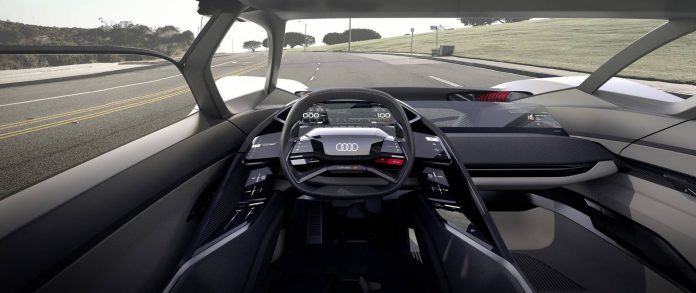Audi have unveiled their big Pebble Beach debut in the form of the Audi PB18 e-tron Concept. The concept takes its name from the Audi R18 e-tron LMP1 racing car that Audi retired a few years ago.
The concept was designed at the new Audi design studio in Malibu, California. It looks very similar, in shape at least, to the Audi Aicon concept from 2017. Design elements such as the side windows and the extended wheel arches are carried over. The similarities are not just skin deep either. The two concept cars share their electric drive systems too.
The R18 e-tron Concept has a sharper focus on performance though, whereas the Aicon was a business jet for the road. In the Audi PB18 e-tron, there are no autonomous driving systems. Keeping things simple, the driver has a steering wheel, a gas pedal and a brake pedal with none of the complex systems found in other Audi Concepts.
The design of the Audi PB18 e-tron Concept includes an inner and outer monocoque. The driver’s seat and cockpit are integrated into an inner monocoque shell which can be positioned in the center of the interior as in a monoposto.
The PB18 e-tron Concept uses the traditional architecture of a mid-engine sports car. The centre of gravity sits behind the seats and in front of the rear axle. It is constructed from a blend of aluminum, carbon and multi-material composites, even with a solid-state battery, it has a total weight of less than 1,550 kg.
The PB18 e-tron has a gently sloping roof line with large C-pillars. The rear window is almost vertical giving it the look of a shooting brake. It is a practical supercar concept with 470 litres of cargo space. The rear gets a pronounced red band of lights and a rear diffuser which can be moved downward mechanically to increase downforce. The rear spoiler is also capable of the same. Laser high-beam headlights are another technical highlight.
Although Audi have opted not to fit autonomous technology to the Audi PB18, it does benefit from a performance specific innovation. The dashboard is a clear panel which allows the driver to see to the tarmac below and better place the car on the track. The clear panel doubles as a transparent OLED screen to show the optimum line.
The powertrain uses three powerful electric motors, one at the front and two in the rear. The rear motors are centrally located between the steering knuckles and each drive one wheel via half-shafts. 150 kW of power is delivered to the front axle and 350 kW to the rear with a total of 500 kW available normally and 570 kW on boost.
830 newton meters (612.2 lb-ft) of torque is available instantaneously with claimed acceleration from 0 to 100 km/h (62.1 mph) in scarcely more than 2 seconds. The liquid-cooled solid-state battery stores 95 kWh of power with a full charge giving a range of over 500 kilometers (310.7 miles). The Audi PB18 e-tron has been designed for charging with a voltage of 800 volts, 15 minutes should see it fully charged.




































